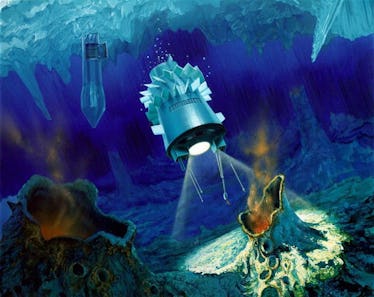What if we could explore subsurface environments just as easily as we’ve been able to explore the surface?
BY LAURENCE TOGNETTI

Planetary exploration, specifically within our own Solar System, has provided a lifetime of scientific knowledge about the many worlds beyond Earth. However, this exploration, thus far, has primarily been limited to orbiters and landers/rovers designed for surface exploration of the celestial bodies they visit. But what if we could explore subsurface environments just as quickly as we’ve been able to explore the surface, and could some of these subsurface dwellings not only shelter future astronauts but host life, as well?
These are questions that a team of researchers at the University of Arizona hope to answer as they examine new technologies that could potentially aid both human and robotic exploration of planetary subsurface environments, including lava tubes, lava caves, and even subsurface oceans. This research comes at a particularly unique time with the NASA Artemis missions preparing to send humans back to the Moon in 2025, then hopefully to Mars someday.
“Lava tubes and caves would make perfect habitats for astronauts because you don’t have to build a structure; you are shielded from harmful cosmic radiation, so all you need to do is make it pretty and cozy,” said Wolfgang Fink, who is an associate professor of electrical and computer engineering at UArizona, and lead author of the study.
For the study, the researchers introduced a dynamically deployed communication network (DDCN) that wirelessly connects robot explorers through a mesh topology network which not only lets each robot explorer work autonomously but also as a team, as the network grants them unfettered communication with each other. This type of system is essential since the geological structure being explored might not be able to relay radio signal commands from astronauts on the outside to the robot explorers on the inside, so an autonomous system could be the best option to achieve mission success. The researchers refer to the DDCN as “a Hansel & Gretel-inspired breadcrumb style” communication network based on how the system is used.
“If you remember the book, you know how Hansel and Gretel dropped breadcrumbs to make sure they’d find their way back,” explained Dr. Fink, who is also the founder and director of the Visual and Autonomous Exploration Systems Research Laboratory at Caltech and UArizona. “In our scenario, the ‘breadcrumbs’ are miniaturized sensors that piggyback on the rovers, which deploy the sensors as they traverse a cave or other subsurface environment.”
Along with the prospects to act as shelter for astronauts, lava tubes and lava caves could also pose astrobiological relevance, as well, as a 2020 paper suggested potential life could evolve within such environments that are shielded from the harsh cosmic radiation.

Image of a lava pit on Mars taken by the HiRISE camera. The pit opening, also called a skylight, is approximately 35 meters (115 feet) across. The pit’s shadow helped scientists estimate that the pit’s depth is approximately 20 meters (65 feet) beneath the surface.
This study builds on previous research undertaken by Dr. Fink, known as tier-scalable reconnaissance, with this study creating a sort of chain of command for the robot explorers without input from human controllers. For example, an orbiter would autonomously control a blimp that’s traversing the surface, which autonomously controls one or more rovers or landers conducting tasks directly on the ground.
Such an autonomous, chain-of-command-like system is already being tested on NASA’s Perseverance rover as it commands its helicopter counterpart, Ingenuity. A proposed mission to explore Saturn’s moon, Titan, could have potentially involved this autonomous system and would have involved an orbiter, balloon, and lander in exploring Titan’s hydrocarbon, methane seas. Unfortunately, the mission was not selected due to funding.
“Once deployed, our sensors automatically establish a nondirected mesh network, which means each node updates itself about each node around it,” said Dr. Fink, who first presented the DDCN idea in a 2019 proposal to NASA.
“They can switch between each other and compensate for dead spots and signal blackouts,” said Dr. Mark A. Tarbell, a senior research scientist in Dr. Fink’s laboratory and a co-author of the study. “If some of them die, there still is connectivity through the remaining nodes, so the mother rover never loses connection to the farthest node in the network.”
For underwater robotic explorers, the lander above the surface—whether floating on a Titan lake or resting on the ice of Europa—would be connected to the submersible via a long cable with communications nodes that could boost any signal trying to get back to the lander. The individual nodes could also have the capability to collect data on their own, such as temperature, pressure, and salinity, and take the data into the cable and send it back to the lander, notes Dr. Fink.

Artist illustration of a future submersible exploring Europa’s ocean.NASA
“Imagine you make it to Europa, you melt your way through miles of ice, make it down to the subsurface ocean, where you find yourself surrounded by alien life, but you have no way of getting data back to the surface,” said Dr. Fink. “That’s the scenario we need to avoid.”
There have been several proposals for sending a lander and even a submersible to Europa, but nothing has been approved as of yet.
How will lava tubes assist in future human and robotic exploration as humanity ventures out farther into the cosmos, and could these subsurface environments host life? Only time will tell, and this is why we science!
This article was originally published on Universe Today by Laurence Tognetti. Read the original article here.


